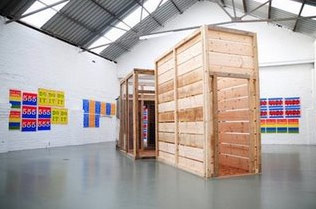
| HOME |
| NERVE |
| REVIEWS |
| ARCHIVE |
| EVENTS |
| LINKS |
| ABOUT US |
| CONTRIBUTORS |
| BACK ISSUES |
| CONTACT US |
 My Empire
of Dirt
My Empire
of Dirt
S. Mark Gubb
Ceri Hand Gallery, Cotton Street
16th January - 28th February 2009, Wed-Sat 10am-6pm
Reviewed by Adam Ford
As I turned down Cotton Street - part of what was once a busy industrial area opposite Liverpool's Trafalgar Dock - Mille Petrozza barked the words "Hordes of chaos; everyone against everyone" down my ear, via my iPod. "Everyone against everyone", he insisted, "against everyone against everyone against everyone against everyone against everyone against everyone". I got quite excited, which was appropriate, considering what I was about to see.
It wasn't appropriate because me, or the singer of German thrash metal band Kreator, or S. Mark Gubb argue for Social Darwinism (we certainly don't), but because to a large extent it's what we all experience in society - even though people talk of 'morals' and 'ethics' - and sometimes it's great when music seems to say, 'Hey! I feel like that too!’
Gubb's love of heavy metal and alternative rock inform much of his work, and the title for this exhibition comes from a line in Nine Inch Nails' 'Hurt', one of the ultimate hymns to alienation, isolation and self-destruction. But the 'shotgun shack' in the centre of the space makes it clear that Gubb also has a more global empire in mind: that of the United States of America.
The shack consists of three tiny adjoined rooms, the first made out of scavenged materials, just like huts in Brazilian favelas, or shantytowns. It is only two metres square, and the promotional material claims this is the amount of space we would each have if the British Isles were divided equally amongst its population (though by my reckoning 315,134 km2 divided by 64.3 million is 4.9m2).
The second room is a reconstruction of the cages that kidnapped 'enemy combatants' suffer in Guantánamo Bay, and other overseas prisons the US runs. Gubb has clearly been affected by the calculatedly cruel aesthetics of the US-led 'war on terror', which looks set to continue under Obama, albeit with a few cosmetic changes. Room three represents an open grave, and refers back to the exhibition title. All three rooms in the shack provoke thoughts of solitude and confinement. Okay, so we may well be put alone in a hole in the ground when we die, but why should we be like that whilst we are alive, literally and symbolically? Is this what a world of everyone against everyone brings?
Many colourful posters designed by Gubb are on show along the white painted brick walls of the space. This inevitably creates a more communal vibe, since in real life posters are designed by someone to give a specific message to a group of people; they are stationary messengers. The colour schemes and slogans suggest they are political, but political posters generally promote a sense of solidarity amongst one faction, identify another as the enemy, and propose some sort of joint action. These slogans are deliberately ambiguous, and require a higher level of analysis. 'Do it' urges one, invoking the Nike advertising slogan, but also a phrase which can apparently be heard if you play Judas Priest's 'Better By You, Better Than Me' backwards. Bizarrely, this almost landed the band in a heap of trouble when two young men attempted suicide! 'Usted Sufre, Pero Por Que?' asks another, which is the title and lyrics of the shortest recording song ever, just translated into Spanish by the internet. Needless to say, most of these allusions would be lost on the average gallerygoer without the complementary notes!
Gubb's old school desk is displayed in a section to one side, complete with an intricately drawn picture of Eddie, the mascot of Iron Maiden. Though he is meant to symbolise the rebellious spirit of heavy metal, he is seen in chains in a padded cell. It's easy to see the appeal this image must have had for the young Gubb; chained to his school desk and longing to be free.
Like a lot of the greatest art, this exhibition looks at the world, finds it nowhere fucking near good enough, and raises questions. In the immortal words of Napalm Death's 1.316-second song: you suffer, but why?